
|
|||||||||||||||
|
| |||||||||||||||
|
Spring waves Sand beneath the kelp beds The kelp canopy Red algae Brown algae Bull-kelp and other annual algae Coralline red algae Leafy red algae Fish and other animals Female sea otters |
Spring waves give the kelp a break At high tide in March, following a stormy winter, you may have a hard time finding any kelp beds along the Central Coast. By March, much of the kelp canopy (the part of the kelp that is visible at the sea surface) has often been removed by winter storm waves. However, March is also the time of year when huge storm swells become less common, and life becomes easier for the kelp. 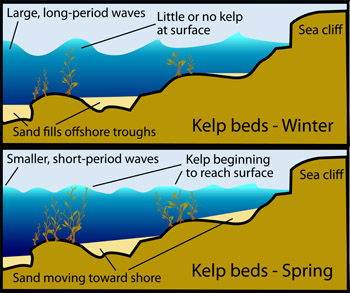 These diagrams show some of the ways that conditions in the kelp beds change as winter progresses into spring time. (Source: Kim Fulton-Bennett) In order to understand how life in the kelp beds changes in March, we first need to consider how the "wave climate" of the Central Coast changes with the end of the winter storm season. As winter storms become less frequent and less severe in March, so do episodes of large surf. Because spring storms are more likely to pass to the north of the Central Coast, their storm waves often approach the coast from the north or northwest. Because spring storms tend to form closer to the coast, their waves are often steep and closely spaced, arriving every seven to ten seconds or so. These "short-period," northwest wind swells do not stir up the ocean as deeply as the long-period groundswells of winter, which can have periods as long as 18 to 22 seconds. In addition, the kelp is already so pruned back that the remaining stipes have few blades, and present relatively little resistance to the waves. Thus, spring waves are less likely to uproot kelp holdfasts or disrupt the young algae that are just starting to grow beneath the kelp during March. Nonetheless, the short-period waves of spring do complete the winter "pruning" of the kelp canopy, allowing plenty of sunlight to reach the sea floor. Short-period waves do not refract, or bend around the contours of the shoreline, as much as do long-period waves. Because of this, spring waves from the northwest seldom cause much damage to kelp beds and intertidal areas along sheltered, south-facing portions of the coast. They do, however, batter exposed north- or northwest-facing coastal areas. The overall effect is that kelp beds and intertidal communities in protected areas begin to regrow and recover from winter storms a month or two before those on the open coast. Sand beneath the kelp beds begins to move toward shore The smaller waves of spring may also cause sand from offshore bars to start moving back toward shore in some areas. Winter storm waves strip sand from the beaches, moving it offshore, where it forms sand bars, and fills "surge channels" in rocky-bottom areas. Thus, in early spring, beaches are often at their narrowest, and sand may be missing entirely from some rocky intertidal areas. Although some beaches may begin to widen in March, this can be a slow and intermittent process, since at any time the shoreward-moving sand may be swept back offshore by an unusually severe late spring storm. As sand bars pass back and forth over rocky subtidal or intertidal areas in spring, they alternately bury and then expose patches of bare rock. Some deep rock channels between kelp beds, for example, may be filled with sand during winter, but are exposed again when this sand moves toward shore in spring or summer. This scour can make is challenging for new, young kelp plants to establish themselves. Within a few weeks of being exposed, such bare rock areas may be colonized by fast-growing seaweeds. Some of these will die if the sand returns. But others can survive burial for days or even weeks, particularly if they grow tall enough so that portions of their blades can are exposed above the sand, where they can gather sunlight. The kelp canopy begins to recover Although the kelp canopy (the part of the kelp you can see at the surface) is typically at its thinnest in February or early March, this is also the time of year when the maximum amount of sunlight reaches the sea floor. In fact, late winter and early spring are the only times of year when unfiltered sunlight is likely to reach the sea floor beneath a Central Coast giant-kelp forest. During summer and fall, the sea floor beneath the giant-kelp canopy is as dark as the forest floor in a redwood forest. These dramatic changes in sunlight allow different types of understory algae to colonize the sea floor beneath giant kelp beds at different times of year. Note: Kelp beds in the more protected parts of Monterey Bay, such as at Capitola or Monterey Harbor, often maintain their canopies throughout the winter. On the other hand, kelp beds in exposed locations, such as along the coast northwest of Santa Cruz, may show little or no surface canopy until May. This delayed recovery benefits the "understory" algae that grow beneath exposed giant-kelp beds because it gives them more time to put on a spring growth spurt before being overshadowed by the giant kelp. Sunlight is essential for the sprouting of new giant kelp, as well as for smaller algae that live beneath the kelp, forming the "bushes" of the kelp forest. As sunlight increases and pulses of nutrient-rich upwelled water bathe the kelp beds in spring, the new kelp sprouts compete with smaller algae and with each other for patches of sunlight and space on the sea floor. Starting in March, giant kelp puts on new growth, with new kelp plants emerging from surviving holdfasts and existing plants, whose upper portions have been pruned by winter storm waves, growing rapidly back toward the sea surface. Red algae colonize bare spots beneath the giant kelp A SCUBA diver exploring the kelp beds in March would see not only new giant kelp stipes beginning to sprout from their holdfasts, but also a variety of small, leafy red algae sprouting on the nearby rocks. Like the giant kelp, many of these red algae are perennial but survive the winter by shedding some or all of their blades. By March, the holdfasts of these dormant red algae are already sending up new sprouts. These sprouts will continue to grow rapidly throughout the upwelling season, until May or June, when the giant-kelp canopy becomes continuous. They spend the summer and fall resting and releasing spores in the dim light beneath the kelp canopy. In addition to the competition for light, competition for space on the sea floor is fierce during the spring growing season, and any bare rock is rapidly colonized by algae or animals. For example, if a giant-kelp holdfast is ripped from the sea floor by a late winter storm, leafy red algae can colonize and completely cover the exposed sea floor within six to eight weeks. Leafy red algae colonize new areas of sea floor by broadcasting microscopic spores. Like pollen from land plants, these spores drift throughout the kelp beds and often form an invisible blanket over the sea floor. Although the algae release spores throughout much of the year, these spores can sprout only when direct sunlight reaches the seafloor in spring. 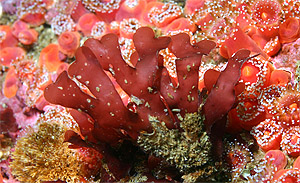 A very young red alga, probably in the genus Rhodymenia, surrounded by strawberry anemones. (Source: Steve Lonhart / SIMoN NOAA ) One of the smaller types of leafy red algae that regrow in March is Rhodymenia californica. Since it rarely grows more than a foot tall, this alga must be particularly good at capturing the dim light that filters down through several layers of understory. In addition to living in the shadows of the giant-kelp forest, it is also found in lower intertidal areas. In these areas, Rhodymenia avoids the bright sunlight by colonizing shady crevices and the undersides of rocks, taking advantage of areas where other algae might not get enough sunlight to survive. Leafy red algae in the genus Plocamium are another weedy species that colonize kelp beds in March. Like Rhodymenia, Plocamium is very good at surviving in low light conditions. In fact, one species, Plocamium pacificum, has been observed growing at depths of well over 120 feet in Monterey Submarine Canyon--deeper than almost any other alga. In shallower water, Plocamium avoids bright sunlight by growing in the shade of giant kelp or (intertidally) surf grass. 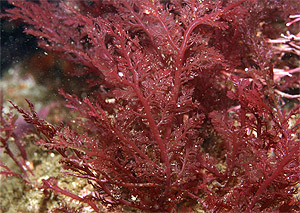 A filamentous red alga, probably in the genus Plocamium. (Source: Steve Lonhart / SIMoN NOAA ) Plocamium's specialty is colonizing rocks that are partially buried or have a thin covering of sand. This allows Plocamium to colonize offshore rocky areas that are exposed early in spring when the sand around the kelp beds begins to move toward shore. Because their foliage often dies back in winter and doesn't have to survive winter storms, the leafy red algae that grow under giant-kelp forests are often relatively fragile and delicate looking. They usually grow better in relatively protected kelp beds such as those within the arc of Monterey Bay. Similarly, these relatively delicate species are often found in deeper parts of the kelp beds, which are less often affected by violent wave action. Brown algae begin to grow back beneath giant kelp Another group of competitors in the spring understory growth race are brown algae in the "kelp" family. Like giant kelp, these brown algae have perennial holdfasts that usually survive winter storms and allow the algae to "save their place" on the rocks from year to year. But they still must grow new blades each spring. Within a few weeks after upwelling begins, you can see their torn blades beginning to repair themselves and new stipes and blades emerging from their holdfasts. In the competition between the red algae and brown algae, you might think of the red algae as the hare and the brown algae as the tortoise. During their spring growth spurt, the red algae expand rapidly to cover large areas of sea floor. By late summer or fall, however, some of these brown algae will have grown five to ten feet tall, and (with the help of the giant kelp) will have begun to shade out the red algae. Pterygophora californica is one perennial brown alga that starts growing early in spring, often competing with young giant kelp for light and space. Pterygophora is a long-lived kelp, whose holdfasts can survive for as long as 16 years. It is also quite adaptable, growing from the low intertidal down to depths of 80 feet or more. Once Pterygophora has gotten established, it seems to be able to prevent small leafy red algae from colonizing the rocks beneath its blades, leaving more room for its own offspring. 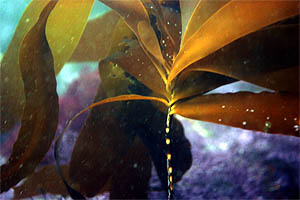 Pterygophora, a near-shore kelp, at Point Lobos. This view shows many blade-like sporophylls emerging the top of the stipe. (Source: Josh Pederson / SIMoN NOAA ) Pterygophora has one main blade that can grow up to eight inches wide and ten feet long. On either side of the main blade are smaller blades known as sporophylls. In fall, the sporophylls will disintegrate, releasing millions of tiny spores. During winter, Pterygophora sheds its main blade and any remaining sporophylls, but retains its thick, stubby stipe and holdfast, from which new blades begin to grow in early spring. Both Laminaria and Pterygophora grow better in relatively exposed giant-kelp beds, such as those along the outermost portions of Monterey Bay. In these areas the brown algae have more opportunities to colonize vacant space because a higher proportion of the kelp is torn out each winter. Pterygophora can survive in sheltered areas such as Stillwater cove (just north of Carmel), but it can only colonize such areas following very severe winters, when its young sprouts can have their "day in the sun" without being shaded out by giant kelp. Bull kelp and other annual algae recolonize exposed coastal areas
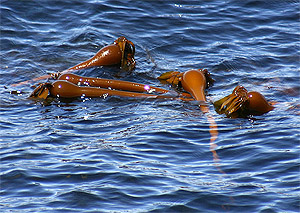 Bull kelp floats and stipes at the sea surface. (Source: Josh Pederson / SIMoN NOAA) If you look out at a kelp bed and see what appear to be lots of sea-otter heads bobbing around, chances are that you're looking a forest of bull kelp (Nereocystis leutkeana). Like giant-kelp beds, bull-kelp forests are likely to be quite sparse in March, since most plants die out during the winter months. But as sunlight increases in spring, new bull-kelp plants sprout from spores and grow rapidly toward the surface. Extending down from each bull-kelp float is a single long, tapering stipe that can be as much as 100 feet long. When bull-kelp stipes wash up on a beach they look like giant bull whips, which is presumably how they got their name. Unlike giant kelp, bull kelp has no blades on its stipe. Instead, the blades all grow from the a ridge on the top of the float, like hair cut in a "Mohawk." Like giant kelp, bull kelp is capable of growing quite rapidly in the proper conditions, and its stipe can grow more than ten inches a day during its peak summer growth period. 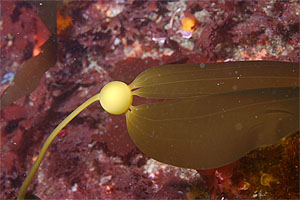 Young bull kelp sprouting from the seafloor. Note the dense growth of red algae on the rocks behind the kelp stipe. (Source: Chad King / SIMoN/NOAA ) New bull kelp spores first begin to sprout on the sea floor in January or February. By March, the new sprouts are growing rapidly, trying to reach the surface waters and sunlight by the time upwelling begins. There may even be a window of time as short as a few weeks for optimum sprouting of bull-kelp spores just before the spring upwelling season. Although bull kelp is considered an annual, a few individuals may live for up to 18 months. Thus, in March you may still be able to see floats from the previous year's bull kelp if the previous winter's storms were not too fierce. Although they may have lost most of their blades in March, these year-old plants will probably survive until fall, when they get a second chance to release spores before dying off entirely. In calm weather, bull-kelp blades hang straight down from the sea surface. However, when exposed to strong winds or currents (which are common on the exposed coast, especially during upwelling events), the blades lie flat along the surface. This allows bull kelp to collect as much sunlight as possible during upwelling events, when it is also being supplied with plenty of fertilizer. Even when full grown in mid summer, bull kelp doesn't cover the entire sea surface as does giant kelp. Thus, bull-kelp forests allow significant amounts of light to reach the sea floor all year long. Because of this consistent sunlight, understory algae in bull kelp forests show less seasonal change than those in giant-kelp forests, despite the fact that they must survive severe winter conditions. The geography of bull kelp Along the most exposed parts of the Central Coast, winter storm waves are so strong and persistent that giant kelp has a hard time surviving. Bull kelp thrives in these areas of cold water and strong, continuous wave action. Bull-kelp forests also have their own distinctive understory algae. The geographic boundary between giant kelp and bull-kelp beds is often quite distinct. For example, most of the kelp beds within Monterey Bay consist of giant kelp. Outside of Monterey Bay, bull kelp becomes abundant on the Big Sur Coast south of Point Lobos. Northwest of the bay, bull kelp begins to appear just south of the town of Davenport, and dominates the kelp beds from Scotts Creek to least Pigeon Point (it's full range extends as far north as Alaska). In winter, these exposed areas receive the full force of the winter swells. In spring, they are often exposed to cold, nutrient-rich upwelled water from nearby upwelling centers. Note: Along some parts of the coast, giant kelp and bull kelp may alternate in abundance over periods of several decades, perhaps in response to long-term cycles in global climate. During extended periods of reduced upwelling, warmer water, and fewer severe storms, giant kelp can begin to colonize relatively exposed coastal areas. On the other hand, during periods of increased upwelling, colder water, and more severe storms, bull kelp may expand its range. Coralline red algae hang tough beneath bull-kelp beds One reason that the bull-kelp understory shows little seasonal change is because it is dominated by some of the most hardy perennial algae--the coralline red algae. Coralline red algae not only survive the wild winters of the exposed coast, but actually put on new growth during the winter season. As their name implies, coralline red algae have hard, coral-like skeletons. Some form tough, scaly crusts on sea-floor rocks. Others have stiff, jointed branches that grow up to several inches long. Many are pinkish or grayish in color. Coralline algae grow in a variety of habitats, including bull-kelp beds, giant-kelp beds, intertidal areas, and deep water beyond the kelp beds. But they do best in areas where strong wave energy weeds out competing algae. Although small and very slow growing, once coralline algae get established, they are tenacious, and often persist for years or even decades. In fact, given enough time, coralline algae may end up filling in the gaps and covering any part of the sea floor that doesn't already support kelp holdfasts or larger algae. Given the harsh wave environment of the bull-kelp beds, it is not surprising that some of the most successful understory algae are little more than thin crusts covering on the rocky bottom. Like lichens on land, these "encrusting" coralline algae start out as little round dots on bare rock surfaces. But given enough time, they can expand to cover entire boulders. Some form thin coatings only a few cells thick; others form overlapping, scaly plates or stony masses up to two inches thick. All of the encrusting coralline algae are very durable. Two genera commonly found in bull-kelp forests, Lithothamnium ("stone branch") and Lithophyllum ("stone leaf"), even have scientific names that suggest their rock-like hardness. Telling the stone leaves and branches apart is apparently no easy feat, even for an expert. One scientist noted that "there are few specialists in the world who profess to know this difficult group." Lithothamnium and Lithophyllum are perennials that can live for decades. Unlike most marine algae, these coralline red algae put on most of their year’s growth during the winter. This is pretty amazing when you consider that during the winter months, these algae may surrounded by murky water and pounded repeatedly by 10- to 20-foot waves. Sharing the space under bull-kelp beds are other coralline red algae with stiff, jointed branches. Two of the more common types of branching coralline algae in bull-kelp beds are the genera Bossiella and Calliarthron. By March, these coralline algae are as lush as they will be all year. This makes them rather conspicuous, since just about all the other understory algae are either regrowing, severely battered, or missing entirely at this time of year. 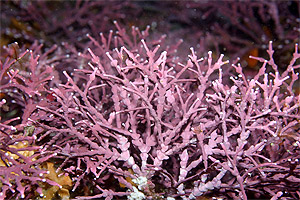 Articulated coralline algae such as this one (possibly in the genus Calliarthron) are very common on rocks down to about 40 feet below the surface. (Source: Steve Lonhart / SIMoN NOAA ) The branches of Bossiella and Calliarthron, like those of other jointed coralline algae, consist of a series of interlocking calcareous segments that look like tiny vertebrae. Just as in a vertebral column, these segments are linked by a tough, fibrous central cord and protected from shock by thin pads that separate one segment from another. The segments look even more skeletal when they turn white due to bleaching by the sun or fresh water. They may also turn white at the tips when reproducing, or when nutrients from spring upwelling events cause them to put on a late growth spurt. Leafy red algae put on a growth spurt beneath bull kelp In addition to the coralline algae, leafy red algae form an important (but more transitory) part of the spring understory beneath bull-kelp beds. Unlike the red understory algae of giant-kelp beds, most of the leafy red algae that grow beneath bull kelp are annuals that live fast and die young. Because they don't have to survive winter storms, these algae often have rather thin, delicate blades. The small, finely branched alga Cumathamnion decipiens, for example, first appears in Monterey Bay in late January, starts reproducing in April, reaches maximum size in May, and usually dies off by the end of June. During its short growing period, the crenulated blades of Cumathamnion decipiens shelters an amazing variety of tiny organisms such as worms, nudibranchs, acorn barnacles, and skeleton shrimp. Fish and other animals colonize the kelp beds Like the understory algae, many kelp-bed animals are just beginning to recover from winter storms in March. For example, some kelp-bed fish move into deeper water during winter storms. As storms become less frequent in March, they may begin to return to the kelp beds. Other fish, including the season's "first wave" of juvenile rockfish, give up their planktonic drifting to settle in or near the kelp beds during March. Many of these young fish rely on the red algae of the understory for hiding places and food. The newly arrived rockfish are voracious predators. One of their favorite foods seems to be drifting larvae, especially barnacle larvae, which are common at this time of year. One study showed that juvenile rockfish can eat so many barnacle larvae that they reduce the number of barnacle larvae arriving in intertidal areas by up to 95 percent compared with coastal areas where rockfish are not present. Young kelp greenling enter the kelp beds 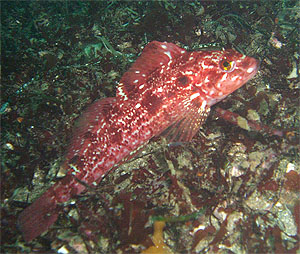 A young kelp greenling, lurking near the seafloor. (Source: Josh Pederson / SIMoN NOAA ) Some of the first juvenile fish to enter the kelp beds in spring are kelp greenling (Hexagrammos decagrammus). After spending more than a year in open water, two- to three-inch-long juveniles typically appear in the kelp beds soon after the first major upwelling event of the spring. When they first enter the kelp forest, young greenling congregate within dense clumps of newly sprouted leafy red algae. These red algae provide the greenling with both food and shelter from larger fish, including others of their own kind. Being one of the first fish to settle into the kelp beds provides several advantages for kelp greenlings. Newly settled juvenile greenling eat a wide variety of food, including red algae, copepods, amphipods, and other small crustaceans. Once settled, however, they switch to eating other small fish--especially other juvenile fishes. Because young greenling grow very rapidly compared with other fishes and are so well developed when they arrive in the kelp beds, they are much faster and stronger than the juvenile fish that enter the kelp beds later in spring. This allows the young greenling to feed on the successive waves of young fish that enter the kelp beds over the next few months. For example, in April or May, large schools of juvenile herring leave Elkhorn Slough and other estuaries. When these young fish enter the kelp beds, they are avidly consumed by the young kelp greenling. In late May or June, swarms of "second wave" juvenile rockfish settle into the kelp beds. At this point, the young kelp greenling switch to eating nothing but rockfish. At other times of year, the rapidly growing greenling will eat whatever they can get their mouths around, including crabs, shrimp, snails, chiton, abalones, octopuses, fish, fish eggs, and algae. Invertebrates colonize the growing kelp In addition to fishes, many kelp-forest invertebrates, such as crabs and snails, also begin to recolonize the kelp beds in March. Some have spent the winter hiding out in rock crevices and kelp holdfasts. Brown turban snails, for example, spend the winter prowling the sea floor, but once the winter storms subside, they begin to crawl up the kelp, heading for the canopy (in those areas where there is a kelp canopy). The same may be true for kelp crabs, which first appear in kelp beds in February or March.
As the kelp canopy expands during spring, so do the number and variety of animals that live there. However, the party in the kelp beds doesn't really get lively until summer, when the canopy is dense and many kelp-forest animals reproduce. Pink sea cucumbers spawn Although summer is when many kelp-bed animals spawn, at least one animal is already starting to reproduce in March. This eager little creature is the pink sea cucumber (Cucumaria miniata), which spawns primarily during spring phytoplankton blooms. Despite their name, "pink" sea cucumbers along the Central Coast are typically brick-red in color and live in cracks in the rocks below the low tide line, curving their ten-inch-long bodies and using their strong tube feet to hold themselves in place. They eat phytoplankton and zooplankton, which they capture using ten bright orange, sticky tentacles. Pink sea cucumbers only extend their tentacles when feeding or spawning, both of which they do during phytoplankton blooms. During their spring spawning events, pink cucumbers put on something of an underwater ballet. When conditions are just right, all the cucumbers in a particular area stretch their bodies out as far as they can from their nooks and crannies and wave their tentacles, swaying from side and releasing clouds of eggs and sperm (a process called broadcast spawning). The eggs and sperm float upward, sometimes forming a visible slick on the sea surface. Because the eggs and sperm are concentrated right at the surface, most of the eggs are fertilized. In contrast, many other broadcast spawners, such as abalone, have very low fertilization rates because their eggs and sperm are dispersed as they drift within the water column. The pink sea cucumber's eggs and larvae are bright orange, which you might think would attract legions of hungry fish. However, these eggs are apparently toxic to most fish, so their release doesn’t incite the feeding frenzies that sometimes accompany other broadcast spawning events. After the eggs hatch, the pink sea cucumber larvae drift for a week or two before settling back down to the sea floor. Since these planktonic larvae do not eat, they do not require phytoplankton for food, so it is not clear why they would be released primarily during phytoplankton blooms. Perhaps these blooms provide the adults with the extra nutrition they need to spawn or coincide with other ocean conditions that help the larvae survive. Female sea otters teach their young to forage As in the open ocean, most of the spring changes in kelp-bed communities are invisible to humans (aside from SCUBA divers). With a pair of binoculars, however, even shore-bound humans can watch marine mammals such as sea otters as they go about their business in March. Sea otters mate and give birth all year long, but the majority of pups are born in mid-winter, from November to January. As befits a creature born in the middle of the storm season, baby sea otters are born with a "life vest" of thick fuzzy fur. Although this fur won't let them sink, it also won't let them dive for food, so they are completely dependent on their mothers for food and protection. By March, some of the year's crop of young otters are already getting too large to nurse (though that doesn't stop them from trying). They have also shed their furry "life vests" for the sleeker coat that will let them dive beneath the waves for food. At this point, you can often see mother sea otters teaching their young how to hunt for food in the kelp beds. March may be a relatively easy time for the young otters to find food because the understory algae is thin, leaving the otters’ crustacean and molluscan prey fewer places to hide. Adult otters often specialize in catching certain types of prey, such as clams or sea urchins. Thus, part of what a mother otter has to do is to teach her youngster the skills needed to catch and eat prey in the area where they live. Only after the basic hunting skills are honed does the mother show her offspring how to use tools, such as rocks, to open the prey they have caught. I find it fascinating that the survival of the young otters (like young humans) depends on their ability to learn essential life skills during an extended period (five to eight months) of "adolescence" and "training." |
